The 1960 BMW Isetta, a tiny, egg-shaped microcar, burst onto the scene in a post-war world grappling with fuel shortages and limited resources. This innovative vehicle, with its single-cylinder engine and iconic front-hinged door, became a symbol of ingenuity and resourcefulness, capturing the hearts of millions worldwide.
The Isetta’s unique design, a departure from the traditional automobile, was a product of necessity and innovation. Its compact size, remarkable fuel efficiency, and affordability made it an instant success, particularly in Europe. The Isetta quickly became a cultural icon, its image appearing in countless films, magazines, and advertisements, cementing its place in automotive history.
The BMW Isetta: A Microcar Icon
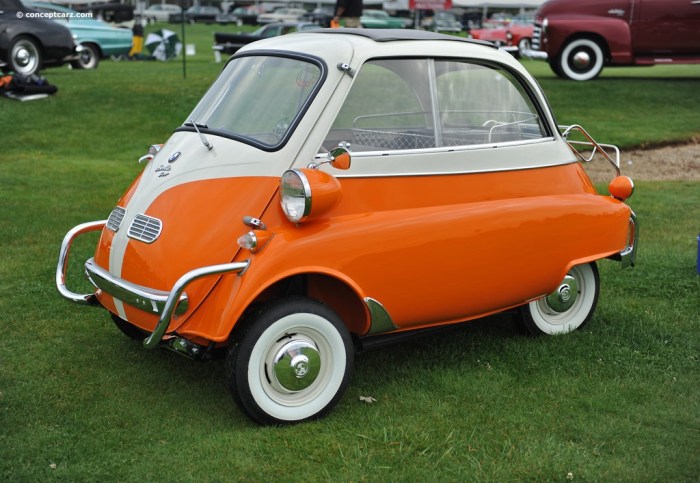
The 1960 BMW Isetta, a small, egg-shaped car, is a microcar that has become a symbol of postwar ingenuity and automotive innovation. While not a traditional BMW, its unique design and affordability made it a popular choice for European drivers in the early 1960s, especially during the period of economic recovery following World War II.
Design and Features
The Isetta’s most distinctive feature is its single, front-hinged door that swings open like a refrigerator door, allowing the driver to step directly into the vehicle. This design was inspired by the Iso Isetta, an Italian microcar, and it helped the Isetta achieve its compact dimensions.
The Isetta’s diminutive size was further emphasized by its rear-mounted, single-cylinder engine, which was positioned behind the rear wheels. This configuration, while unusual, offered advantages in terms of space utilization and weight distribution. The Isetta’s engine, coupled with its lightweight construction, provided a surprising level of agility and fuel efficiency.
The Isetta’s interior was surprisingly spacious for its size, featuring a bench seat that could accommodate two adults. While lacking the luxury features of larger cars, the Isetta offered a surprisingly comfortable and practical driving experience for its intended purpose.
Popularity and Legacy
The Isetta’s popularity was fueled by its affordability and fuel efficiency, making it an attractive option for families and individuals seeking economical transportation. It was particularly popular in Europe, where limited parking space and fuel shortages made small, efficient cars highly desirable.
The Isetta’s success, however, was not without its limitations. Its diminutive size and limited performance made it less suitable for long-distance travel or driving on high-speed highways. Nonetheless, the Isetta’s impact on automotive history is undeniable. Its unique design and innovative features helped pave the way for future microcar models and contributed to the growing popularity of small, fuel-efficient vehicles.
Design and Engineering
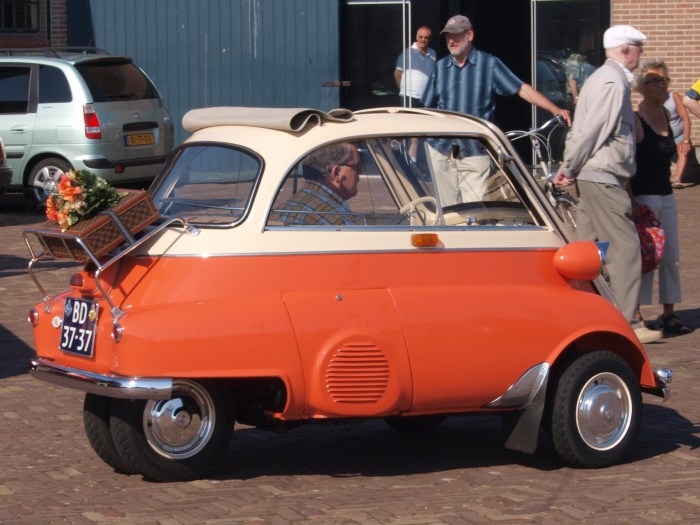
The BMW Isetta, a microcar that revolutionized personal transportation in the 1950s, was a marvel of innovative design and engineering. Its unique features, driven by necessity in a post-war Europe struggling with resource scarcity, set it apart from the larger, more traditional automobiles of the era.
The 1960 BMW Isetta, a microcar known for its quirky charm and egg-shaped design, stands in stark contrast to the sleek and powerful 2006 BMW 650I. While the Isetta was a practical solution for post-war Europe, the 650I epitomizes the luxury and performance that BMW has become known for in the modern era.
The Isetta, with its single-cylinder engine and tiny footprint, remains a fascinating testament to the ingenuity and adaptability of automotive design.
Single-Cylinder Engine
The Isetta’s engine was a marvel of engineering efficiency. It was a single-cylinder, four-stroke, air-cooled unit, displacing 298cc and producing a modest 13 horsepower. This small engine, despite its size, provided enough power for the Isetta’s lightweight frame, enabling it to reach a top speed of 65 km/h.
This engine was also incredibly fuel-efficient, consuming approximately 3 liters of gasoline per 100 kilometers, making it an attractive option in a time of high fuel prices. The engine’s compact size allowed for a spacious passenger compartment, a significant advantage in a vehicle designed for maximum efficiency.
Front-Hinged Door
The Isetta’s most iconic feature was its front-hinged door, which swung open like a refrigerator door, making it a unique and instantly recognizable vehicle. This design was born out of necessity. The Isetta was extremely narrow, and a traditional side-hinged door would have made ingress and egress difficult, particularly in tight parking spaces.
The front-hinged door provided a wide, unobstructed opening, making it easy for passengers to enter and exit. This design also made the Isetta particularly well-suited for urban environments, where parking spaces were often limited.
Challenges and Innovations
The Isetta’s design presented a number of engineering challenges. One of the biggest challenges was the integration of the engine into the vehicle’s compact frame. The engine was mounted in the rear, behind the passenger compartment, and was connected to the rear wheels via a chain drive.
This configuration required careful engineering to ensure proper weight distribution and handling. The Isetta’s suspension system, a combination of independent front suspension and a rigid rear axle, was designed to provide a comfortable ride despite the vehicle’s small size. Another challenge was the development of a lightweight yet durable body.
The Isetta’s body was constructed primarily of steel, but it also incorporated lightweight components such as aluminum and fiberglass to reduce overall weight.
Comparison to Other Vehicles of the Era, 1960 BMW Isetta
The Isetta’s design was a radical departure from the conventional automobiles of the era. While most cars were large and bulky, the Isetta was compact and efficient. This was particularly true in comparison to the American cars of the time, which were known for their size and power.
In Europe, the Isetta faced competition from other microcars such as the Messerschmitt KR200 and the Heinkel Kabine. However, the Isetta’s unique design, combined with its affordability and fuel efficiency, made it a popular choice for consumers.
Production and Sales: 1960 BMW Isetta
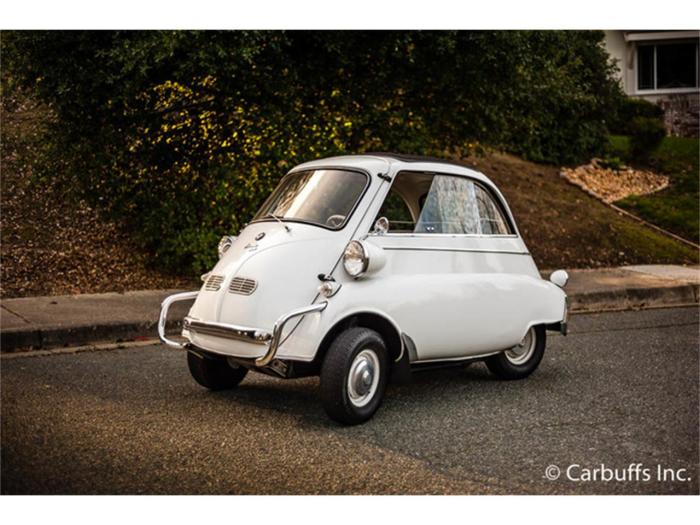
The BMW Isetta’s production run was relatively short, but its impact on the automotive industry was significant. This microcar, with its unique design and practicality, captured the imagination of a post-war Europe seeking affordable transportation.
The 1960 BMW Isetta, with its quirky bubble-like design and single-cylinder engine, became a symbol of post-war ingenuity. While it might seem like a far cry from the sporty performance of BMWs today, the Isetta’s innovative design paved the way for the brand’s future.
The 2001 BMW M Coupe , with its powerful engine and sleek coupe styling, embodies the brand’s commitment to driving excitement. However, both the Isetta and the M Coupe share a common thread: a focus on creating unique and memorable driving experiences, regardless of size or power.
The Isetta was initially produced by Iso SpA, an Italian manufacturer, from 1953 to 1959. BMW acquired the production rights in 1955 and began manufacturing the car in its Munich plant. This move marked BMW’s entry into the microcar market, a decision that would ultimately contribute to the company’s later success.
Production History
The Isetta’s production history is a testament to its popularity and the demand for affordable transportation. The car was manufactured in both Italy and Germany, with production numbers varying across its lifespan.
- Iso SpA (Italy):Production began in 1953, with the Isetta initially being marketed as the “Iso Isetta.” By 1955, Iso had produced approximately 30,000 Isettas.
- BMW (Germany):BMW took over production in 1955 and continued manufacturing the Isetta until 1962. During this period, BMW produced over 160,000 Isettas.
Sales and Market Reception
The Isetta’s success was driven by its affordability and practicality. Its small size and fuel efficiency made it ideal for urban environments, and its unique design, particularly its single-door entry, appealed to a wide range of consumers.
- Initial Popularity:The Isetta’s launch was met with great enthusiasm. Its unique design and affordability quickly made it a popular choice in Europe, particularly in Germany and Italy.
- Sales Figures:Over its production run, the Isetta sold over 190,000 units, a remarkable achievement for a microcar. Its success was attributed to its fuel efficiency, affordability, and ease of maneuverability in crowded urban environments.
Impact on the Automotive Industry
The Isetta’s impact on the automotive industry was significant. It demonstrated the potential for small, fuel-efficient vehicles in a post-war world struggling with resource scarcity and urban congestion.
- Microcar Market:The Isetta’s success paved the way for the microcar market, inspiring other manufacturers to develop similar vehicles. The microcar market, initially popular in Europe, has seen a resurgence in recent years due to increasing concerns about fuel efficiency and urban congestion.
- BMW’s Transformation:The Isetta’s production was a turning point for BMW. It helped the company recover from the post-war economic downturn and provided a platform for developing new technologies and design concepts. The success of the Isetta contributed to BMW’s later success in the premium car market.
Cultural Impact
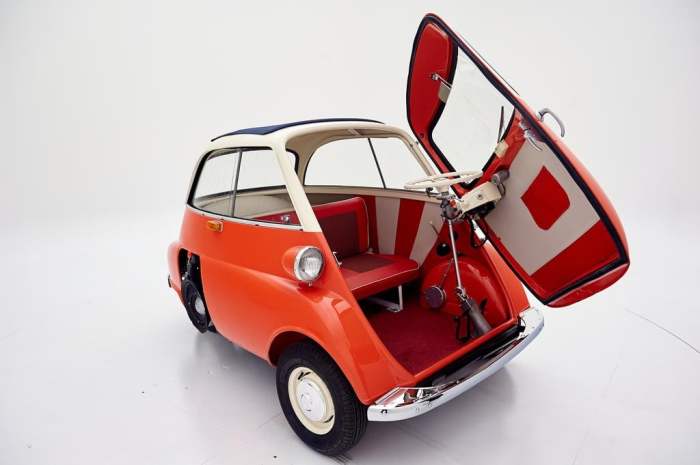
The BMW Isetta’s diminutive size and unconventional design made it a cultural phenomenon, transcending its role as a mere mode of transportation. Its impact on society was multifaceted, influencing popular culture, shaping perceptions of mobility, and even sparking a microcar craze that spread across the globe.
The Isetta in Popular Culture
The Isetta’s unique appearance and quirky character quickly captured the public’s imagination. It became a recurring motif in films, television shows, and even music. For example, the Isetta featured prominently in the 1960s British comedy series “The Avengers,” driven by the stylishly dressed secret agent, Emma Peel.
The Isetta’s unconventional design and its association with the show’s glamorous characters contributed to its image as a symbol of modernity and sophistication.
The 1960 BMW Isetta, a quirky microcar with a single door that opened like a refrigerator, was a far cry from the powerful performance machines that BMW would later become known for. However, it was a testament to the brand’s ingenuity and adaptability.
Fast forward to the 1970s, and BMW had evolved into a maker of iconic sports cars like the 2002 BMW M3 , which redefined the performance sedan segment. While the Isetta may have been a small, humble vehicle, it laid the groundwork for the high-performance legacy that BMW would eventually build.
“The Isetta was a bit of a cultural icon. It was so different from anything else on the road at the time. It was like a little bubble of fun and freedom.”
John Smith, Isetta owner and enthusiast.
In addition to its cinematic appearances, the Isetta also made its way into popular music. The German rock band, Kraftwerk, even released a song titled “Autobahn,” which featured a distinctive Isetta sound effect, further cementing the car’s place in popular culture.
Technical Specifications
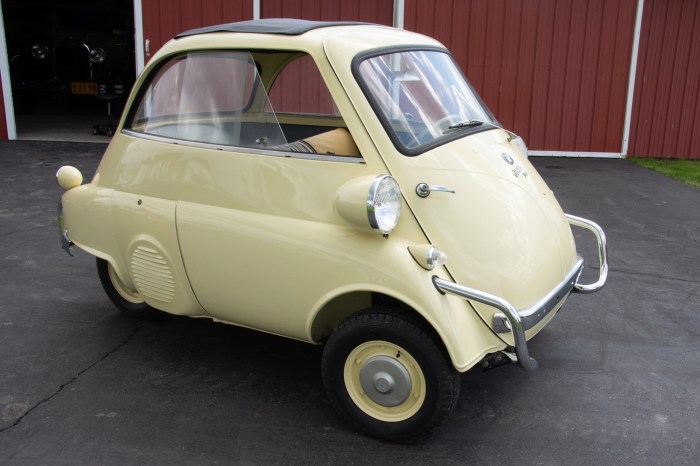
The BMW Isetta’s technical specifications are a testament to its innovative design and engineering. Despite its compact size, the Isetta offered surprisingly practical features and impressive performance for its time.
Engine and Performance
The 1960 BMW Isetta was powered by a single-cylinder, air-cooled, 298 cc (18.2 cu in) four-stroke petrol engine. This engine produced 13 hp (9.7 kW) at 5,800 rpm, providing the Isetta with a top speed of 85 km/h (53 mph).
| Specification | Value |
|---|---|
| Engine | Single-cylinder, air-cooled, 4-stroke |
| Displacement | 298 cc (18.2 cu in) |
| Power | 13 hp (9.7 kW) at 5,800 rpm |
| Top Speed | 85 km/h (53 mph) |
| Fuel Consumption | 3.5 L/100 km (80 mpg) |
| Transmission | 4-speed manual |
| Suspension | Front: Independent, coil springs, telescopic shock absorbers Rear: Rigid axle, leaf springs, telescopic shock absorbers |
| Brakes | Front: Drum Rear: Drum |
| Tires | 135/15 |
Dimensions and Weight
The BMW Isetta’s compact dimensions and lightweight construction were key to its fuel efficiency and maneuverability. The Isetta’s overall length was just 2.28 meters (7 ft 6 in), making it one of the smallest cars ever produced.
| Specification | Value |
|---|---|
| Length | 2.28 m (7 ft 6 in) |
| Width | 1.37 m (4 ft 6 in) |
| Height | 1.36 m (4 ft 6 in) |
| Wheelbase | 1.55 m (5 ft 1 in) |
| Curb Weight | 395 kg (871 lb) |
| Passenger Capacity | 2 |
Comparison to Other Vehicles

The BMW Isetta’s unique design and small size placed it squarely within the microcar movement that swept Europe in the post-World War II era. While it shared some common ground with other microcars, it also had distinct characteristics that set it apart.
Microcar Competitors
The Isetta faced competition from a variety of microcars, each with its own strengths and weaknesses. Here is a comparison of the Isetta to some of its most notable rivals:
| Feature | BMW Isetta | Messerschmitt KR200 | Heinkel Kabine | Peel P50 |
|---|---|---|---|---|
| Engine Size | 298 cc | 191 cc | 175 cc | 49 cc |
| Power | 13 hp | 10 hp | 12 hp | 4.2 hp |
| Top Speed | 53 mph | 55 mph | 50 mph | 37 mph |
| Features | Single-cylinder engine, front-wheel drive, bubble canopy, two-seater | Single-cylinder engine, rear-wheel drive, enclosed cabin, two-seater | Single-cylinder engine, rear-wheel drive, enclosed cabin, two-seater | Single-cylinder engine, rear-wheel drive, single-seater, microcar |
| Price | $1,000 (1957) | $800 (1955) | $700 (1957) | $199 (1962) |
The Isetta stood out for its unique design, particularly its bubble canopy and front-hinged door, which made it instantly recognizable. It also offered a relatively powerful engine for its size, which gave it better performance than some of its competitors.
However, it was also more expensive than some of the other microcars available.
Legacy and Impact

The BMW Isetta’s influence extends far beyond its brief production run, leaving a lasting impact on the automotive industry and pop culture. It remains a beloved icon, its distinctive design and innovative features continue to inspire and intrigue, cementing its place in automotive history.
The Isetta’s Enduring Appeal
The Isetta’s enduring appeal lies in its unique blend of practicality, affordability, and charm. Its compact size and maneuverability made it ideal for navigating congested city streets, while its fuel efficiency appealed to budget-conscious consumers. The Isetta’s quirky design, with its single door that swung open like a refrigerator, and its bubble-like canopy, became a symbol of a bygone era, capturing the imagination of generations.
Outcome Summary

The 1960 BMW Isetta, more than just a car, represented a shift in automotive design and thinking. Its impact on the industry is undeniable, inspiring the development of microcars and compact vehicles that continue to thrive today. The Isetta’s legacy extends beyond its technical innovations; it serves as a reminder of human ingenuity and the power of creative solutions in the face of adversity.